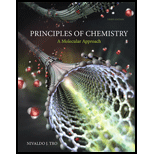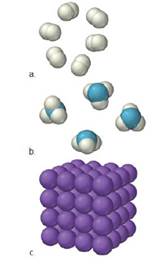
Principles of Chemistry: A Molecular Approach Plus Mastering Chemistry with eText -- Access Card Package (3rd Edition) (New Chemistry Titles from Niva Tro)
3rd Edition
ISBN: 9780321971166
Author: Nivaldo J. Tro
Publisher: PEARSON
expand_more
expand_more
format_list_bulleted
Concept explainers
Textbook Question
Chapter 3, Problem 9E
Based on the molecular views, classify each substance as an atomic element, a molecular element, an ionic compound, or a molecular compound.

Expert Solution & Answer
Want to see the full answer?
Check out a sample textbook solution
Students have asked these similar questions
Define and provide an example for each of the following: atomic element, molecular element, ionic compound, and molecular compound?
In 1808 John Dalton published his atomic theory which was quickly adopted. The five tenets of Dalton's theory are
An element is composed of tiny indivisible, indestructible particles called atoms.
All the atoms of an element are identical and have the same properties.
Atoms of different elements combine to form compounds.
Compounds contain atoms in ratios of small whole numbers.
Atoms can combine in more than one ratio to form different compounds.
Although all of the statements were valid at the time, several have been modified as new discoveries were made. Which of these tenets have been modified? What caused the modification?
Differentiate between Molecular and Ionic Compounds?
Chapter 3 Solutions
Principles of Chemistry: A Molecular Approach Plus Mastering Chemistry with eText -- Access Card Package (3rd Edition) (New Chemistry Titles from Niva Tro)
Ch. 3 - Prob. 1SAQCh. 3 - Which substance is an ionic compound? a. SrI2 b....Ch. 3 - What is the correct formula for the compound...Ch. 3 - Prob. 4SAQCh. 3 - What is the formula for manganese (IV) oxide? a....Ch. 3 - Name the compound Pb(C2H3O2)2. a....Ch. 3 - Name the compound P2I4. a. Phosphorus iodide b....Ch. 3 - Prob. 8SAQCh. 3 - Prob. 9SAQCh. 3 - List the element in the compound CF2Cl2, in order...
Ch. 3 - Determine the mess of potassium in 35.59 of KBr....Ch. 3 - Prob. 12SAQCh. 3 - Prob. 13SAQCh. 3 - Prob. 14SAQCh. 3 - Prob. 15SAQCh. 3 - Prob. 3.1PCh. 3 - For Practice 3.2 Classify each substance as an...Ch. 3 - Prob. 3.3PCh. 3 - Prob. 3.4PCh. 3 - Prob. 3.5PCh. 3 - Prob. 3.5MPCh. 3 - For Practice 3.6 Name the compound FeS.Ch. 3 - Prob. 3.6MPCh. 3 - Prob. 3.7PCh. 3 - Prob. 3.7MPCh. 3 - Prob. 3.8PCh. 3 - Prob. 3.8MPCh. 3 - Prob. 3.9PCh. 3 - For Practice 3.10 Name the oxyacid HNO2(aq).Ch. 3 - Prob. 3.10MPCh. 3 - For Practice 3.11 Calculate the formula mass of...Ch. 3 - Prob. 3.12PCh. 3 - Prob. 3.12MPCh. 3 - Prob. 3.13PCh. 3 - For More Practice 3.10 Calculate the mass percent...Ch. 3 - For Practice 3.14 Determine the mass of oxygen in...Ch. 3 - Prob. 3.14MPCh. 3 - Prob. 3.15PCh. 3 - Prob. 3.16PCh. 3 - Prob. 3.17PCh. 3 - Prob. 3.17MPCh. 3 - Prob. 3.18PCh. 3 - Prob. 3.19PCh. 3 - Prob. 3.20PCh. 3 - Prob. 3.21PCh. 3 - Prob. 3.22PCh. 3 - Prob. 1ECh. 3 - Prob. 2ECh. 3 - Prob. 3ECh. 3 - Prob. 4ECh. 3 - Prob. 5ECh. 3 - Prob. 6ECh. 3 - Prob. 7ECh. 3 - Classify each compound as ionic or molecular a....Ch. 3 - Based on the molecular views, classify each...Ch. 3 - Prob. 10ECh. 3 - Prob. 11ECh. 3 - Prob. 12ECh. 3 - Prob. 13ECh. 3 - Prob. 14ECh. 3 - Prob. 15ECh. 3 - Prob. 16ECh. 3 - Prob. 17ECh. 3 - Prob. 18ECh. 3 - Prob. 19ECh. 3 - Prob. 20ECh. 3 - Prob. 21ECh. 3 - Prob. 22ECh. 3 - Prob. 23ECh. 3 - Prob. 24ECh. 3 - Prob. 25ECh. 3 - Prob. 26ECh. 3 - Name each molecular compound. a. CO b. NI3 C....Ch. 3 - Prob. 28ECh. 3 - Prob. 29ECh. 3 - Prob. 30ECh. 3 - Prob. 31ECh. 3 - Prob. 32ECh. 3 - Prob. 33ECh. 3 - Prob. 34ECh. 3 - Prob. 35ECh. 3 - 36. Calculate the formula mass for each...Ch. 3 - CaIcuIate the number of moles in each sample. a....Ch. 3 - Prob. 38ECh. 3 - Prob. 39ECh. 3 - Prob. 40ECh. 3 - Prob. 41ECh. 3 - Prob. 42ECh. 3 - Prob. 43ECh. 3 - Prob. 44ECh. 3 - Prob. 45ECh. 3 - Prob. 46ECh. 3 - Most fertilizers consist of nitrogen-containing...Ch. 3 - Iron is mined from the Earth as iron ore. Common...Ch. 3 - Prob. 49ECh. 3 - Prob. 50ECh. 3 - Prob. 51ECh. 3 - Prob. 52ECh. 3 - Prob. 53ECh. 3 - Prob. 54ECh. 3 - Prob. 55ECh. 3 - Prob. 56ECh. 3 - Prob. 57ECh. 3 - Prob. 58ECh. 3 - Prob. 59ECh. 3 - Prob. 60ECh. 3 - Prob. 61ECh. 3 - Prob. 62ECh. 3 - 63. Calculate the empirical formula for each...Ch. 3 - Prob. 64ECh. 3 - Prob. 65ECh. 3 - Prob. 66ECh. 3 - Prob. 67ECh. 3 - Prob. 68ECh. 3 - Prob. 69ECh. 3 - Prob. 70ECh. 3 - Prob. 71ECh. 3 - Prob. 72ECh. 3 - Sulfuric acid is a component of acid rain that...Ch. 3 - Prob. 74ECh. 3 - Prob. 75ECh. 3 - Prob. 76ECh. 3 - Prob. 77ECh. 3 - Prob. 78ECh. 3 - Prob. 79ECh. 3 - Prob. 80ECh. 3 - Prob. 81ECh. 3 - Prob. 82ECh. 3 - Prob. 83ECh. 3 - Prob. 84ECh. 3 - Prob. 85ECh. 3 - Prob. 86ECh. 3 - Prob. 87ECh. 3 - Prob. 88ECh. 3 - Determine the chemical formula of each compound...Ch. 3 - Prob. 90ECh. 3 - Prob. 91ECh. 3 - Prob. 92ECh. 3 - Prob. 93ECh. 3 - Prob. 94ECh. 3 - Prob. 95ECh. 3 - Prob. 96ECh. 3 - Prob. 97ECh. 3 - 98. Estrone, which contains only carbon, hydrogen,...Ch. 3 - Prob. 99ECh. 3 - Prob. 100ECh. 3 - A compound of molar mass 177 g/mol contains only...Ch. 3 - Prob. 102ECh. 3 - Prob. 103ECh. 3 - Prob. 104ECh. 3 - Prob. 105ECh. 3 - Prob. 106ECh. 3 - Prob. 107ECh. 3 - A particular brand of beef jerky contanins 0.0552%...Ch. 3 - Prob. 109ECh. 3 - Prob. 110ECh. 3 - Prob. 111ECh. 3 - Prob. 112ECh. 3 - Prob. 113ECh. 3 - Prob. 114ECh. 3 - Prob. 115ECh. 3 - Prob. 116ECh. 3 - Prob. 117ECh. 3 - Prob. 118ECh. 3 - Prob. 119ECh. 3 - Prob. 120ECh. 3 - Prob. 121ECh. 3 - Prob. 122ECh. 3 - Prob. 123ECh. 3 - Prob. 124ECh. 3 - Prob. 125ECh. 3 - Prob. 126E
Knowledge Booster
Learn more about
Need a deep-dive on the concept behind this application? Look no further. Learn more about this topic, chemistry and related others by exploring similar questions and additional content below.Similar questions
- A small crystal of CaCl2 that weighs 0.12 g contains 6.5 1020 formula units of CaCl2. What is the total number of ions (cations and anions) that make up this crystal?arrow_forwardContrast the two general types of chemical compounds in terms of their general physical properties.arrow_forwardClassify the following as compounds or elements: a silver bromide used in photography; b calcium carbonate limestone; c sodium hydroxide lye; d uranium; e tin; f titanium.arrow_forward
- Which of the following statements is/are always true? Never true? Usually true? (a) Compounds containing chlorine can be either molecular or ionic. (b) An ionic compound always has at least one metal. (c) When an element in a molecule has a di prefix, it means that the element has a +2 charge.arrow_forwardThese questions concern the work of J. J. Thomson: From Thomson’s work, which particles do you think he would feel are most important in the formation of compounds (chemical changes) and why? Of the remaining two subatomic particles, which do you place second in importance for forming compounds and why? Come up with three models that explain Thomson’s findings and evaluate them. To be complete you should include Thomson’s findings.arrow_forwardIn Groups 4A-6A, there are several elements whose symbols begin with S. Name these elements, and for each one give its symbol, atomic number, group number, and period. Describe each as a metal, metalloid, or nonmetal.arrow_forward
- Sketch a magnified view (showing atoms/molecules) of each of the following and explain: a. a heterogeneous mixture of two different compounds b. a homogeneous mixture of an element and a compoundarrow_forward< Complete the table below by writing the symbols for the cation and anion that make up each ionic compound. The first row has been completed for you. ionic compound cation NaCl Ni(OH)₂ (NH₂)₂0 Na 0 0 MnCl₂ 0 v₂(SO₂), 0 anion Cl 0 0 0 5arrow_forward32. Based on the molecular views, classify each substance as an atomic element, a molecular element, an ionic compound, or a molecular compound. (b) (a) (c)arrow_forward
arrow_back_ios
arrow_forward_ios
Recommended textbooks for you
 General Chemistry - Standalone book (MindTap Cour...ChemistryISBN:9781305580343Author:Steven D. Gammon, Ebbing, Darrell Ebbing, Steven D., Darrell; Gammon, Darrell Ebbing; Steven D. Gammon, Darrell D.; Gammon, Ebbing; Steven D. Gammon; DarrellPublisher:Cengage Learning
General Chemistry - Standalone book (MindTap Cour...ChemistryISBN:9781305580343Author:Steven D. Gammon, Ebbing, Darrell Ebbing, Steven D., Darrell; Gammon, Darrell Ebbing; Steven D. Gammon, Darrell D.; Gammon, Ebbing; Steven D. Gammon; DarrellPublisher:Cengage Learning ChemistryChemistryISBN:9781305957404Author:Steven S. Zumdahl, Susan A. Zumdahl, Donald J. DeCostePublisher:Cengage Learning
ChemistryChemistryISBN:9781305957404Author:Steven S. Zumdahl, Susan A. Zumdahl, Donald J. DeCostePublisher:Cengage Learning
 Chemistry: The Molecular ScienceChemistryISBN:9781285199047Author:John W. Moore, Conrad L. StanitskiPublisher:Cengage Learning
Chemistry: The Molecular ScienceChemistryISBN:9781285199047Author:John W. Moore, Conrad L. StanitskiPublisher:Cengage Learning Chemistry: Principles and PracticeChemistryISBN:9780534420123Author:Daniel L. Reger, Scott R. Goode, David W. Ball, Edward MercerPublisher:Cengage Learning
Chemistry: Principles and PracticeChemistryISBN:9780534420123Author:Daniel L. Reger, Scott R. Goode, David W. Ball, Edward MercerPublisher:Cengage Learning

General Chemistry - Standalone book (MindTap Cour...
Chemistry
ISBN:9781305580343
Author:Steven D. Gammon, Ebbing, Darrell Ebbing, Steven D., Darrell; Gammon, Darrell Ebbing; Steven D. Gammon, Darrell D.; Gammon, Ebbing; Steven D. Gammon; Darrell
Publisher:Cengage Learning

Chemistry
Chemistry
ISBN:9781305957404
Author:Steven S. Zumdahl, Susan A. Zumdahl, Donald J. DeCoste
Publisher:Cengage Learning


Chemistry: The Molecular Science
Chemistry
ISBN:9781285199047
Author:John W. Moore, Conrad L. Stanitski
Publisher:Cengage Learning

Chemistry: Principles and Practice
Chemistry
ISBN:9780534420123
Author:Daniel L. Reger, Scott R. Goode, David W. Ball, Edward Mercer
Publisher:Cengage Learning

Step by Step Stoichiometry Practice Problems | How to Pass ChemistryMole Conversions Made Easy: How to Convert Between Grams and Moles; Author: Ketzbook;https://www.youtube.com/watch?v=b2raanVWU6c;License: Standard YouTube License, CC-BY